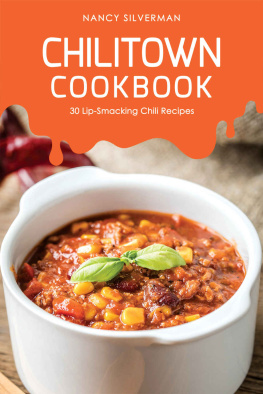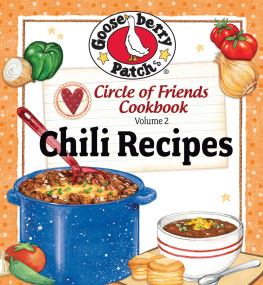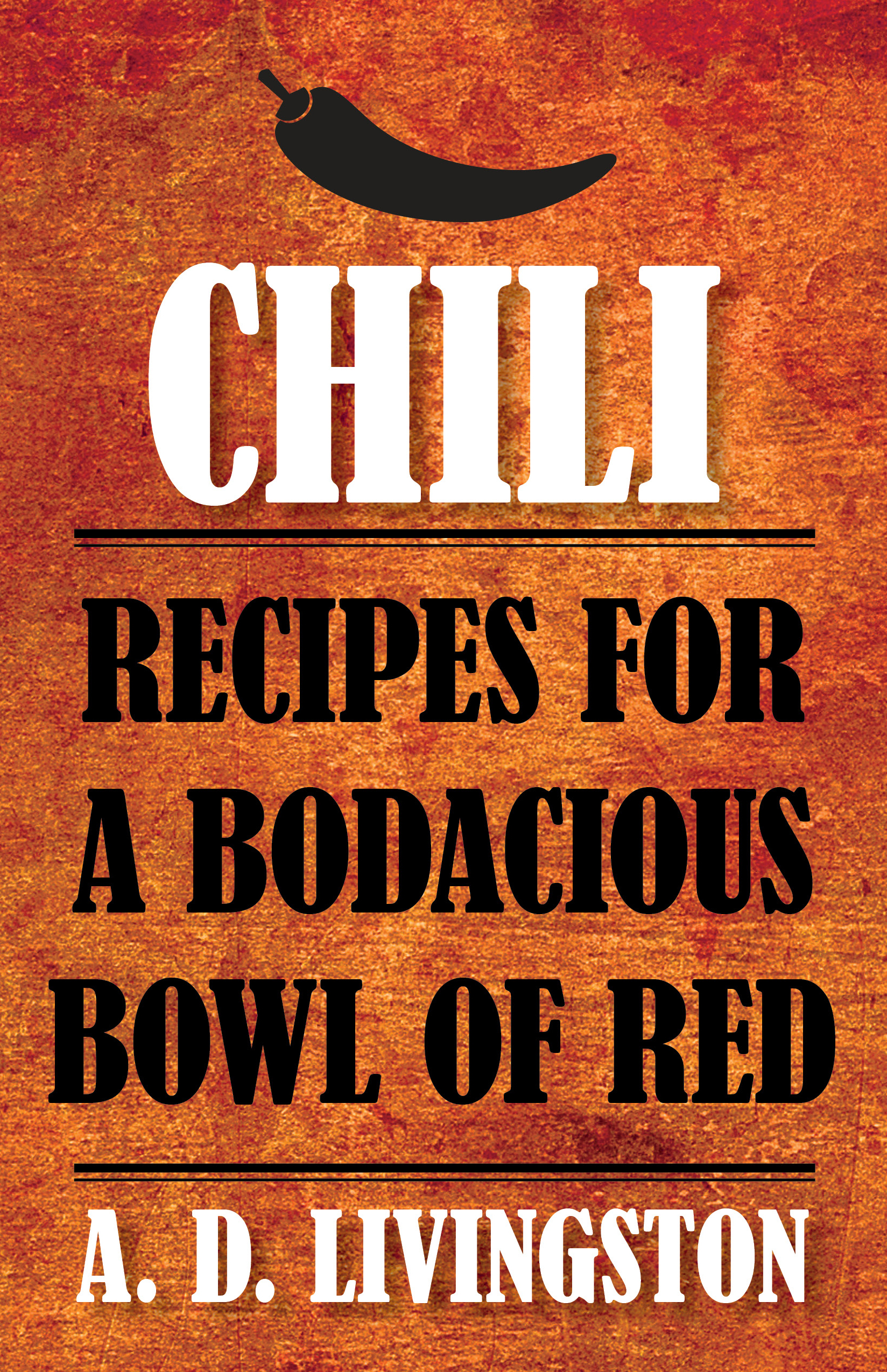CHILI
Other Cookbooks by A. D. Livingston
Jerky
Sausage
Cold-Smoking & Salt-Curing Meat, Fish, & Game
Cast-Iron Cooking
The Curmudgeons Book of Skillet Cooking
Complete Fish & Game Cookbook
The Freshwater Fish Cookbook
Venison Cookbook
The Whole Grain Cookbook
CHILI
RECIPES FOR A BODACIOUS BOWL OF RED
A. D. LIVINGSTON
Copyright 2003, 2013 by A. D. Livingston
ALL RIGHTS RESERVED. No part of this book may be reproduced or transmitted in any form by any means, electronic or mechanical, including photocopying and recording, or by any information storage and retrieval system, except as may be expressly permitted in writing from the publisher. Requests for permission should be addressed to Globe Pequot Press, Attn: Rights and Permissions Department, PO Box 480, Guilford, CT 06437.
Lyons Press is an imprint of Globe Pequot Press.
Recipe on page 134 (page number refers to the printed book) by Ed Martley, from Cooking Alaskan 1983, is reprinted by permission of Alaska Northwest Books, an imprint of Graphic Arts Center Publishing Co.
Project Editor: Tracee Williams
Layout: Maggie Peterson
Text Design: Elizabeth Kingsbury
Library of Congress Cataloging-in-Publication data is on file.
ISBN 978-1-4930-0605-2
To the memory of Gary Cox, chilihead
Contents
Introduction
Chili is simply a meat stew defined by chile peppers. Indeed, the early Spanish name for the dish was chile con carne chiles with meat. That old name doesnt quite say it all, but it comes pretty close. Using lots of mild dried chile peppers and plenty of meat is the key to a superior and authentic chili. Its the chile pepper bulk that counts, not the heat; consequently, the chile pepper (mild kinds) should be considered a substantial ingredient, not just a spice. Unfortunately, however, the chile pepper has tended to diminish in importance as our chili recipes have become longer and longer, with more and more nonessential ingredients being added to the list.
Its true that a good bowl of chili isnt completely ruined by the addition of a little of this and a pinch of that. The real stuff stands up pretty well. What really bothers me, however, is whats being left out of some modern recipes. Its also true that modern concoctions can retain a certain taste (primarily from cumin, a latecomer to the list of essential ingredients) without the use of lots of dried chile pulp or pure chile powderbut the chili loses its strength and its soul.
If used in sufficient plenty, dried red chile peppers (usually in powdered form) add flavor, nutrition, bulk, and a certain smooth texture to chili. Moreover, its the chile pepper, not the tomato, that puts the deep color into an authentic bowl of red.
Fortunately for modern cooks, dried red chile peppers of one kind or another (to be discussed at some length in the second chapter) are becoming more widely available these dayseven in some supermarkets and Walmartsand this trend is almost certain to continue. These dried peppers have a rather long shelf life and a reasonable price if purchased in bulk. For those who dont want to start from scratch, pure chile powder is available, also by the pound or in small packages, from dozens of modern pepper varieties. In either case, we could well be on the verge of a renaissance in great home-cooked chili. I can only hope that this modest work will help light the way.
A. D. Livingston
PART ONE
Chili Ways and Means
The inspiration for raising the bar on modern chili lies in the past. Thats why this books starts off in chapter 1 on a historical note along with recipes for basic old-time chili that will not taste quite like our modern versions. I think the flavor and texture and color of the real stuffmade with only three or four essential ingredientsare important and should be experienced before we dump the vegetable garden and the spice rack into the pot.
Fortunately, the scheme for this book allows us to start cooking in the first chapter instead of bogging down in a hundred pages of introductory stuff. More than once this approach has gotten me into difficulties with editors and people in the book business, causing one female critic to say that a cookbook of mine was about as organized as a bachelors closet. So, be prepared to rummage around a little. Maybe youll run across a surprise or uncover a secret here and there.
Chapter 2 is simply a primer on chile peppers, which I think is necessary for a modern chili book because dozens of varieties are becoming readily available to home cooks across the land for the first time. How exactly the chapter fits into the books organization is difficult to explain and impossible to defend, except to say that it ought to go somewhere up front. Its simply too detailed for the introduction, however, and doesnt serve my agenda very well if its forced into chapter 1. So, its chapter 2. Personally, I think it follows naturally from chapter 1, where a case is made for returning the chile to our chili, but my critics may disagree. In any case, I hope that my recipe on making chili from scratchthat is, from whole dried red peppers, not from powderwill save the day.
Chapter 3 contains some important topics of contention for those few of us who like to be a little fussy about chili cooking details, along with some basics for those jacklegs amongst us who dont know how to simmer a stew and end up boiling it or, worse, scorching it. Of course, to boil chili vigorously is a cardinal sin.
Chapters 4 and 5 should present no special problems and need no explanation here, but chapter 6 might require comment. I wont mount an outright defense of this chapter, except to say that it is quite detailed and I admit to allowing it to run on somewhat unchecked. This seems to be the best way I can reflect the chaotic state of modern chili, in which almost anything and everything goes into the pot. Merely saying this is not enough. I need to hammer it in, nail by nailwielding each small blow with clenched teeth and a wry smile. Who will fail to be a little amused to find that a contestant in a modern chili cook-off put prunes into the pot?
REDISCOVERING CHILI
Many are the theories and stories about the origins of chili. My favorite one concerns a beautiful and mysterious holy lady reported to have preceded the Spanish missionaries into northern Mexico, apparently to prepare the Native Americans for things to come. She was dressed in blue. This figure may have been Mary of Agreda, a nun in an order that called for blue dress. Trouble is, Sister Mary never left her convent in Spain. In the early 1600s, however, she was said to go into trances for several days and awaken with vivid memories of foreign lands. This has been described as an out-of-body experience. After one such visit to the New World, she reportedly wrote down a recipe the Native Americans had given to her. It consisted simply of venison, chile peppers, tomatoes, and onions, all simmered together in a clay pot. Thats it.
Whether it be fact or fancy, Ill have to say here that Sister Marys recipe contains a good deal of truth and reflects what I like to call the lost soul of modern chili. The Indians had the peppers and the venison and it would be unreasonable to believe that they wouldnt have combined the two, along with some wild onion. What could be more logical for a Mexican peasant recipe, far from the sophisticated Aztec cookery of Tenochtitln (now Mexico City, where another version of early chili is said to have been made with chile peppers, tomatoes, and the meat of scrawny Spanish explorers)?










